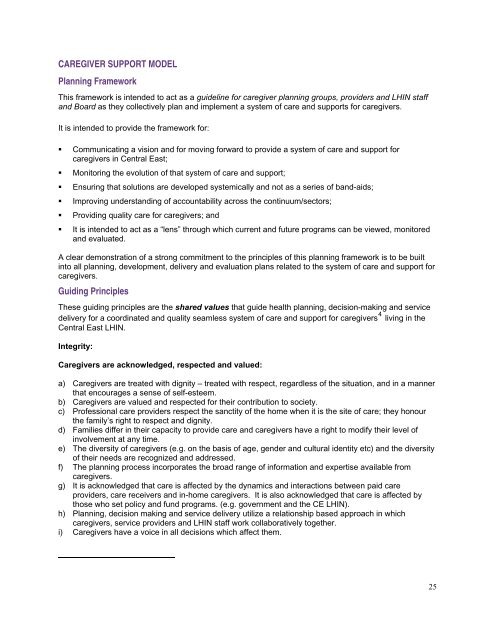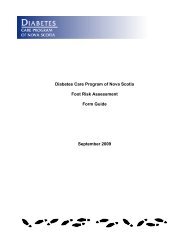Caregiver Support and Well-Being Priority Project - Central East ...
Caregiver Support and Well-Being Priority Project - Central East ...
Caregiver Support and Well-Being Priority Project - Central East ...
You also want an ePaper? Increase the reach of your titles
YUMPU automatically turns print PDFs into web optimized ePapers that Google loves.
CAREGIVER SUPPORT MODELPlanning FrameworkThis framework is intended to act as a guideline for caregiver planning groups, providers <strong>and</strong> LHIN staff<strong>and</strong> Board as they collectively plan <strong>and</strong> implement a system of care <strong>and</strong> supports for caregivers.It is intended to provide the framework for:• Communicating a vision <strong>and</strong> for moving forward to provide a system of care <strong>and</strong> support forcaregivers in <strong>Central</strong> <strong>East</strong>;• Monitoring the evolution of that system of care <strong>and</strong> support;• Ensuring that solutions are developed systemically <strong>and</strong> not as a series of b<strong>and</strong>-aids;• Improving underst<strong>and</strong>ing of accountability across the continuum/sectors;• Providing quality care for caregivers; <strong>and</strong>• It is intended to act as a “lens” through which current <strong>and</strong> future programs can be viewed, monitored<strong>and</strong> evaluated.A clear demonstration of a strong commitment to the principles of this planning framework is to be builtinto all planning, development, delivery <strong>and</strong> evaluation plans related to the system of care <strong>and</strong> support forcaregivers.Guiding PrinciplesThese guiding principles are the shared values that guide health planning, decision-making <strong>and</strong> servicedelivery for a coordinated <strong>and</strong> quality seamless system of care <strong>and</strong> support for caregivers 4 living in the<strong>Central</strong> <strong>East</strong> LHIN.Integrity:<strong>Caregiver</strong>s are acknowledged, respected <strong>and</strong> valued:a) <strong>Caregiver</strong>s are treated with dignity – treated with respect, regardless of the situation, <strong>and</strong> in a mannerthat encourages a sense of self-esteem.b) <strong>Caregiver</strong>s are valued <strong>and</strong> respected for their contribution to society.c) Professional care providers respect the sanctity of the home when it is the site of care; they honourthe family’s right to respect <strong>and</strong> dignity.d) Families differ in their capacity to provide care <strong>and</strong> caregivers have a right to modify their level ofinvolvement at any time.e) The diversity of caregivers (e.g. on the basis of age, gender <strong>and</strong> cultural identity etc) <strong>and</strong> the diversityof their needs are recognized <strong>and</strong> addressed.f) The planning process incorporates the broad range of information <strong>and</strong> expertise available fromcaregivers.g) It is acknowledged that care is affected by the dynamics <strong>and</strong> interactions between paid careproviders, care receivers <strong>and</strong> in-home caregivers. It is also acknowledged that care is affected bythose who set policy <strong>and</strong> fund programs. (e.g. government <strong>and</strong> the CE LHIN).h) Planning, decision making <strong>and</strong> service delivery utilize a relationship based approach in whichcaregivers, service providers <strong>and</strong> LHIN staff work collaboratively together.i) <strong>Caregiver</strong>s have a voice in all decisions which affect them.25
















